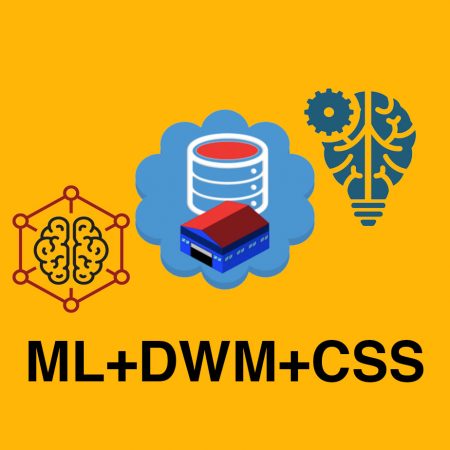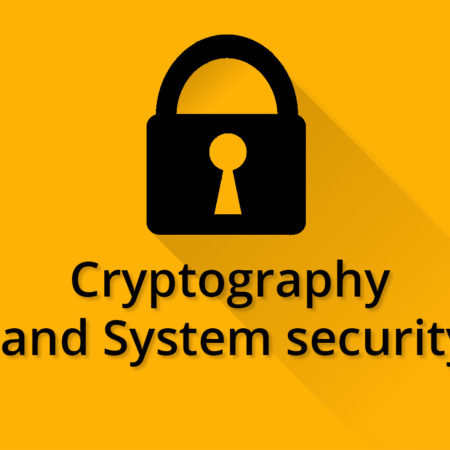Data Compression and Encryption
₹1,200.00
-
Introduction to Data Compression
-
Data Security
-
Number Theory and Asymmetric Key Cryptography
-
Network Security
-
Extra
- DOS and DDOS Attack
- IPSEC introduction
- IP SEC Security Protocols
- IPSEC Modes of Operation
- IDS and its Types
- Buffer Overflow and Buffer Overflow attack
- Malicious Software ( Virus and worms )
- Virus and worms
- SQL Injection
- IDEA Algorithm Full Working Copy
- Blowfish Algorithm Full working Copy
- Confusion and Diffusion Copy
- Meet in the Middle Copy
- Phishing Attack Copy
- Session Hijacking and Spoofing Attack Copy
- OS Security Memory and Address Protection Copy
- E commerce Security and Payment gateway Copy
-
Encryption NOTES
Data Compression and Encryption
Objectives of course Data Compression and Encryption is to introduce classical encryption techniques and concepts of modular arithmetic and number theory.
To explore the working principles and utilities of various cryptographic algorithms including secret key cryptography, hashes and message digests, and public key algorithms. To explore the design issues and working principles of various authentication protocols, PKI standards and various secure communication standards including Kerberos, IPsec, and SSL/TLS and email. To develop the ability to use existing cryptographic utilities to build programs for secure communication. Outcomes of course Cryptography and System Security are that at the end of the course learner will able to. Understand system security goals and concepts, classical encryption techniques and acquire fundamental knowledge on the concepts of modular arithmetic and number theory. Understand, compare and apply different encryption and decryption techniques to solve problems related to confidentiality and authentication. Apply the knowledge of cryptographic checksums and evaluate the performance of different message digest algorithms for verifying the integrity of varying message sizes. Apply different digital signature algorithms to achieve authentication and design secure applications Understand network security basics, analyze different attacks on networks and evaluate the performance of firewalls and security protocols like SSL, IPSec, and PGP. Analyze and apply system security concept to recognize malicious code.
Cryptography, or cryptology is the practice and study of techniques for secure communication in the presence of third parties called adversaries. More generally, cryptography is about constructing and analyzing protocols that prevent third parties or the public from reading private messages;[3] various aspects in information security such as data confidentiality, data integrity, authentication, and non-repudiation[4] are central to modern cryptography. Modern cryptography exists at the intersection of the disciplines of mathematics, computer science, electrical engineering, communication science, and physics. Applications of cryptography include electronic commerce, chip-based payment cards, digital currencies, computer passwords, and military communications.
Module Introduction & Number Theory covers the topic such as Security Goals, Services, Mechanisms and attacks, The OSI security architecture, Network security model, Classical Encryption techniques, Symmetric cipher model, mono-alphabetic and polyalphabetic substitution techniques such as Vigenere cipher, playfair cipher, Hill cipher, transposition techniques: keyed and keyless transposition ciphers, steganography. Modular Arithmetic and Number Theory Euclid‘s algorithm-–Prime numbers-Fermat‘s and Euler‘s theorem- Testing for primality -The Chinese remainder theorem, Discrete logarithms. Module Symmetric and Asymmetric Key Cryptography and key Management covers the topic such as Block cipher principles, block cipher modes of operation, DES, Double DES, Triple DES, Advanced Encryption Standard (AES), Stream Ciphers: RC5 algorithm. Public key cryptography Principles of public key cryptosystems-The RSA algorithm, The knapsack algorithm, ElGamal Algorithm. Key management techniques: using symmetric and asymmetric algorithms and trusted third party. Diffie Hellman Key exchange algorithm. Module Hashes, Message Digests and Digital Certificates covers the topic such as Cryptographic hash functions, Properties of secure hash function, MD5, SHA-1, MAC, HMAC, CMAC. Digital Certificate: X.509, PKI. Authentication Protocols & Digital signature schemes. User Authentication and Entity Authentication, One-way and mutual authentication schemes, Needham Schroeder Authentication protocol, Kerberos Authentication protocol. Digital Signature Schemes – RSA, EIGamal and Schnorr signature schemes. Module Network Security and Applications covers the topic such as Network security basics like TCP/IP vulnerabilities (Layer wise), Packet Sniffing, ARP spoofing, port scanning, IP spoofing, TCP syn flood, DNS Spoofing. Denial of Service: Classic DOS attacks, Source Address spoofing, ICMP flood, SYN flood, UDP flood, Distributed Denial of Service, Defenses against Denial of Service Attacks. Internet Security Protocols: SSL, IPSEC, Secure Email: PGP, Firewalls, IDS and types, Honey pots. Module System Security covers the topic such as Software Vulnerabilities like Buffer Overflow, Format string, cross-site scripting, SQL injection, Malware: Viruses, Worms, Trojans, Logic Bomb, Bots, Rootkits. Suggested Reference Books for Cryptography and System Security by Mumbai University are as follows Applied Cryptography, Protocols Algorithms and Source Code in C, Bruce Schneier, Wiley. Cryptography and Network Security, Atul Kahate, Tata Mc Graw Hill. Suggested Text Books for Cryptography and System Security by Mumbai University are as follows William Stallings, Cryptography and Network Security, Principles and Practice, 6 th Edition, Pearson Education, March 2013. Behrouz A. Ferouzan, Cryptography & Network Security, Tata Mc Graw Hill. Bernard Menezes, Cryptography & Network Security, Cengage Learning. Network Security Bible, Eric Cole, Second Edition, Wiley.
Prepare For Your Placements: https://lastmomenttuitions.com/courses/placement-preparation/
![]()
/ Youtube Channel: https://www.youtube.com/channel/UCGFNZxMqKLsqWERX_N2f08Q
Follow For Latest Updates, Study Tips & More Content!
Course Features
- Lectures 54
- Quizzes 0
- Language Hindi
- Students 0
- Certificate No
- Assessments Yes



